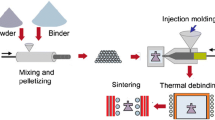Abstract
This paper concerns the study of sintering phenomenon during rotational molding of polypropylene(PP),Polyvinylidenefluoride (PVDF) and Polymethyl methacrylate (PMMA). First, the coalescence (first step of sintering) of two grains has been followed. Bellehumeur’s model has been tested as a model to explain this phenomenon. In order to study the effect of neighboring grains on coalescence of two grains, a third grain has been put in contact with these two grains. For modeling the phenomenon in this case, Bellehumeur’s model has been modified by a geometric parameter called Farz Factor (FF), being this model validated by experimental test. Concerning densification, two different stages have been observed. In the first stage, before welding of the grains and formation of interphases between them, the grains are not stuck yet. The air trapped between the grains escapes through free ways between grains. This first step of densification is directly related to the coalescence where the density of the polymer varies very quickly. A new tridimensional model, based on a Body Centered Tetragonal (BCT) configuration, has been proposed to explain the densification during this first stage. In the second stage, the migration of air is controlled by diffusion.


















Similar content being viewed by others
References
Crawford RJ, Throne JL (2002) Rotational molding technology. William Andrew Publishing, New York
Tcharkhtchi A (2004) Rotomoulage de pièces en matière thermoplastique, Techniques de l’ingénieur, AM 3706, 1–1
Rao MA, Throne JL (1972) Principles of rotational molding. Polym Eng Sci 12:237–264
Bonis LJ, Hausner HH, Lontz J (1964) Sintering of polymer materials. Sintering and plastic deformation. Springer, US, pp 25–47
Asgarpour M, Bakir F, Khelladi S, Khavandi A, Tcharkhtchi A (2011) Characterization and modeling of sintering of polymer particles. J Appl Polym Sci 119:2784–2792
Greco A, Maffezzoli A (2003) Polymer melting and polymer powder sintering by thermal analysis. J Therm Anal Calorim 72:1167–1174
Bellehumeur CT, Bisaria MK, Vlachopoulos J (1996) An experimental study and model assessment of polymer sintering. Polym Eng Sci 36:2198–2207
Rosenzweig N, Narkis M (1981) Sintering rheology of amorphous polymers. Polym Eng Sci 21:1167–1170
Mazur S (1995) Coalescence of polymer particles in polymer powder technology. Wiley, Chiechester, chapter 8
He Y, Howes T, Litster JD, Ko GH (2002) Experimental study of drop-interface coalescence in the presence of polymer stabilisers. Colloids Surf A Physicochem Eng Asp 207:89–104
Frenkel J (1945) Viscous flow of cristalline bodies under the action of surface tension. J Phys 16:385–391
Lontz JF (1964) Sintering of polymer materials, in Fundamental phenomena in the material sciences. Plenum press, New York, pp 25–47
Pokluda O, Bellehumeur CT, Vlachopoulos J (1997) Modification of Frenkel’s model for sintering. AIChE J 43(12):3253–3256. doi:10.1002/aic.690431213
Pop-Iliev R, Rizvi GM, Park CB (2003) The importance of timely polymer sintering while processing polypropylene foams in rotational molding. Polym Eng Sci 43(1):40–54
Bellehumeur C, Li L, Sun Q, Gu P (2004) Modeling of bond formation between polymer filaments in the fused deposition modeling process. J Manuf Process 6(2):170–178
Progelhof RC, Cellier G and Throne JL (1982) New technology in rotational molding powder densification. In: “Society of Plastics Eng. Annual Technical Conference”, San Francisco, USA, 28:627–629
Asgarpour M, Bakir F, Khelladi S, Khavandi A, Tcharkhtchi A (2012) 3D model for powder compact densification in rotational molding. Polym Eng Sci 52(9):2033–2040
Park H, Thompson RB, Lanson N, Tzoganakis C, Park CB, Chen P (2007) Effect of temperature and pressure on surface tension of polystyrene in supercritical carbon dioxide. J Phys Chem B 111(15):3859–3868. doi:10.1021/jp065851t
Pérot E (2006) Optimisation et modélisation du procédé de rotomoulage. INSA de Lyon
Muller J-D (2008) Etude des changements de phase de polymère dans le procédé de rotomoulage: coalescence et cristallisation couplées à la thermique du procédé. INSA de Lyon
Kontopoulou M, Vlachopoulos J (2001) Melting and densification of thermoplastic powders. Polym Eng Sci 41(2):155–169. doi:10.1002/pen.10718
Asgarpour M (2010) Analyse et modélisation de la coalescence et de la densification des grains de polymére lors du procédé de rotomoulage, Arts et Métiers ParisTech
Gogos G (2004) Bubble removal in rotational molding. Polym Eng Sci 44(2):388–394. doi:10.1002/pen.20035
Xu L, Crawford RJ (1993) Analysis of the formation and removal of gas bubbles in rotationally moulded thermoplastics. J Mater Sci 28(8):2067–2074. doi:10.1007/bf00367563
AG Spence (1994) Analysis of bubble formation and removal in rotationally moulded products. PhD thesis, The Queen’s University of Belfast
Author information
Authors and Affiliations
Corresponding author
Rights and permissions
About this article
Cite this article
Hamidi, A., Farzaneh, S., Nony, F. et al. Modelling of sintering during rotational moulding of the thermoplastic polymers. Int J Mater Form 9, 519–530 (2016). https://doi.org/10.1007/s12289-015-1239-6
Received:
Accepted:
Published:
Issue Date:
DOI: https://doi.org/10.1007/s12289-015-1239-6




